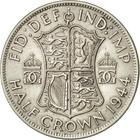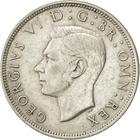Halfcrown, Coin Type from United Kingdom - detailed information
| ||||
The Halfcrown (Half Crown) was a denomination of British money, equivalent to two shillings and sixpence, or one-eighth of a pound. The half crown was first issued in 1549, in the reign of Edward VI. No half crowns were issued in the reign of Mary, but from the reign of Elizabeth I half crowns were issued in every reign except Edward VIII, until the coins were discontinued in 1967. During the English Interregnum of 1649 - 1660, a republican half crown was issued, bearing the arms of the Commonwealth of England, despite monarchist associations of the coin's name. When Oliver Cromwell made himself Lord Protector of England, half crowns were issued bearing his semi-royal portrait. The half crown did not display its value on the reverse until 1893. Sterling silver halfcrowns (struck between 1911 and 1919) were also current in Australia although the denomination had not been selected for inclusion among the coins struck by the Commonwealth of Australia beginning in 1910. When the British debased the silver in 1920 no proclamation was issued in Australia making them legal tender however some did circulate, being brought out by migrants. By the early 1930s, after a sustained effort to remove them from circulation, the use of British coins in Australia had ended (although some halfpence were still in use as late as 1966). The denomination was struck in sterling silver (92.5%) for most of its existence; it was debased to 50% silver in 1920, then debased entirely to copper-nickel in 1947. The halfcrown was demonetised (ahead of other pre-decimal coins) on 1 January 1970, the year before the United Kingdom adopted decimal currency on Decimal Day. | ||||
| ||||
| ||||
| ||||
| ||||
| ||||
 |
| Buy Silver and Gold Bullion Online! |
| Coin Name | Reverse | Obverse | Details |
|---|---|---|---|
| Halfcrown 1937 |  |
 |
Material: 0.500 Silver Mint: Royal Mint Mintage: 9,132,842 |
| Halfcrown 1938 |  |
 |
Material: 0.500 Silver Mint: Royal Mint Mintage: 6,426,478 |
| Halfcrown 1939 |  |
 |
Material: 0.500 Silver Mint: Royal Mint Mintage: 15,478,635 |
| Halfcrown 1940 |  |
 |
Material: 0.500 Silver Mint: Royal Mint Mintage: 17,948,439 |
| Halfcrown 1941 |  |
 |
Material: 0.500 Silver Mint: Royal Mint Mintage: 15,773,984 |
| Halfcrown 1942 |  |
 |
Material: 0.500 Silver Mint: Royal Mint Mintage: 31,220,090 |
| Halfcrown 1943 |  |
 |
Material: 0.500 Silver Mint: Royal Mint Mintage: 15,462,875 |
| Halfcrown 1944 |  |
 |
Material: 0.500 Silver Mint: Royal Mint Mintage: 15,255,165 |
| Halfcrown 1945 |  |
 |
Material: 0.500 Silver Mint: Royal Mint Mintage: 19,849,242 |
| Halfcrown 1946 |  |
 |
Material: 0.500 Silver Mint: Royal Mint Mintage: 22,724,873 |
| Halfcrown 1947 |  |
 |
Material: CuproNickel Mint: Royal Mint Mintage: 21,911,484 |
| Halfcrown 1948 |  |
 |
Material: CuproNickel Mint: Royal Mint Mintage: 71,164,703 |
| Halfcrown 1949 |  |
 |
Material: CuproNickel Mint: Royal Mint Mintage: 28,272,512 |
| Halfcrown 1950 |  |
 |
Material: CuproNickel Mint: Royal Mint Mintage: 28,353,013 |
| Halfcrown 1951 |  |
 |
Material: CuproNickel Mint: Royal Mint Mintage: 9,003,520 |
| Halfcrown 1952 |
Material: CuproNickel Mint: Royal Mint Mintage: 2 |
||
| Halfcrown 1953 |  |
 |
Material: CuproNickel Mint: Royal Mint Mintage: 3,923,214 |
| Halfcrown 1954 |  |
 |
Material: CuproNickel Mint: Royal Mint Mintage: 11,614,953 |
| Halfcrown 1955 |  |
 |
Material: CuproNickel Mint: Royal Mint Mintage: 23,628,726 |
| Halfcrown 1956 |  |
 |
Material: CuproNickel Mint: Royal Mint Mintage: 33,934,909 |
| Halfcrown 1957 |  |
 |
Material: CuproNickel Mint: Royal Mint Mintage: 34,200,563 |
| Halfcrown 1958 |  |
 |
Material: CuproNickel Mint: Royal Mint Mintage: 15,745,688 |
| Halfcrown 1959 |  |
 |
Material: CuproNickel Mint: Royal Mint Mintage: 9,028,844 |
| Halfcrown 1960 |  |
 |
Material: CuproNickel Mint: Royal Mint Mintage: 19,929,191 |
| Halfcrown 1961 |  |
 |
Material: CuproNickel Mint: Royal Mint Mintage: 25,887,897 |
| Halfcrown 1962 |  |
 |
Material: CuproNickel Mint: Royal Mint Mintage: 23,998,112 |
| Halfcrown 1963 |  |
 |
Material: CuproNickel Mint: Royal Mint Mintage: 17,572,800 |
| Halfcrown 1964 |  |
 |
Material: CuproNickel Mint: Royal Mint Mintage: 4,576,800 |
| Halfcrown 1965 |  |
 |
Material: CuproNickel Mint: Royal Mint Mintage: 8,124,800 |
| Halfcrown 1966 |  |
 |
Material: CuproNickel Mint: Royal Mint Mintage: 14,811,200 |
| Halfcrown 1967 |  |
 |
Material: CuproNickel Mint: Royal Mint Mintage: 21,000,000 |
| Halfcrown 1970 (Proof only) |
Material: CuproNickel Mint: Royal Mint Mintage: 750,476 |
||
|
Showing 101 to 132 of 132 Coins. | |||
 |
| London Mint Office coins. |
| Country | United Kingdom |
|---|---|
| Currency | Pound Sterling (pre-decimal) |
| Sub-types |
Halfcrown King George III, Large Head Halfcrown King George III, Small Head Halfcrown King George IV, First Issue Halfcrown King George IV, Second Issue Halfcrown King George IV, Third Issue Halfcrown King William IV Halfcrown Queen Victoria, First Issue Halfcrown Queen Victoria, Second Issue Halfcrown Queen Victoria, Third Issue Halfcrown Edward VII and George V Halfcrown George V and George VI Halfcrown Elizabeth II |
| From | 1816 |
| To | 1970 |
| Face Value | 2 1/2 (x Shilling) |
| Current | No (demonetised 1970) |
| Material | 0.925 Silver |
| Designer | |
| Technology | Milled (machine-made) |
| Shape | Round |
| Size | |
| Mass | 14.1380 g |
 |
| Buy Silver Bullion Online |
| Image | Details |
|---|---|

|
Coin - Halfcrown, George III, Great Britain, 1816
Copyright: Museums Victoria / CC BY Author: Justine Philip Notes: King George III, First Issue (1816 - 1817). Source |

|
Coin - Halfcrown, George III, Great Britain, 1818
Copyright: Museums Victoria / CC BY Author: Justine Philip Notes: King George III, Second Issue (1817 - 1820). Source |

|
Great Britain 1820 1/2 crown KM-676
Copyright: CoinFactsWiki / CC BY-SA Author: Heritage Auction Galleries Notes: King George IV, First Reverse (1820 - 1823). Source |

|
Coin - Halfcrown, George IV, Great Britain, 1823
Copyright: Museums Victoria / CC BY Author: Justine Philip Notes: King George IV, Second Reverse (1823 - 1824). Source |

|
Coin - Halfcrown, George IV, Great Britain, 1826
Copyright: Museums Victoria / CC BY Author: Justine Philip Notes: King George IV, Third Reverse (1824 - 1829). Source |

|
Proof Coin - Halfcrown, William IV, Great Britain, 1831
Copyright: Museums Victoria / CC BY Author: Justine Philip Notes: King William IV (1831 - 1837). Source |

|
Proof Coin - Halfcrown, Queen Victoria, Great Britain, 1880
Copyright: Museums Victoria / CC BY Author: Justine Philip Notes: Queen Victoria, First Issue (1839 - 1887). Source |

|
Coin - Halfcrown, Queen Victoria, Great Britain, 1889
Copyright: Museums Victoria / CC BY Author: Justine Philip Notes: Queen Victoria, Second Issue (1887 - 1892). Source |

|
Great Britain 1899 half crown
Copyright: CoinFactsWiki / CC BY-SA Author: Heritage Auction Galleries Notes: Queen Victoria, Third Issue (1893 - 1901). Source |

|
Coin - Halfcrown, George V, Great Britain, 1911
Copyright: Museums Victoria / CC BY Author: Justine Philip Notes: Edward VII and George V (1902 - 1927). Source |

|
Proof Coin - Halfcrown, George V, Great Britain, 1928
Copyright: Museums Victoria / CC BY Author: Justine Philip Notes: King George V, Second Issue (1927 - 1936). Source |

|
Proof Coin - Halfcrown, George VI, Great Britain, 1937
Copyright: Museums Victoria / CC BY Author: Justine Philip Notes: King George VI, Emperor of India (silver 1937 - 1946, copper-nickel 1947, 1948). Source |

|
Proof Coin - Halfcrown, Elizabeth II, Great Britain, 1953
Copyright: Museums Victoria / CC BY Author: Justine Philip Notes: Queen Elizabeth II (1953 - 1970). Source |

|
Coin - Halfcrown, George III, Great Britain, 1816
Copyright: Museums Victoria / CC BY Author: Justine Philip Notes: King George III, "Bull Head" portrait (1816 - 1817). Source |

|
Coin - Halfcrown, George III, Great Britain, 1818
Copyright: Museums Victoria / CC BY Author: Justine Philip Notes: Notes: King George III, "Small Head" portrait (1817 - 1820). Source |

|
Great Britain 1820 1/2 crown KM-676
Copyright: CoinFactsWiki / CC BY-SA Author: Heritage Auction Galleries Notes: King George IV, "First Head" (1820 - 1824). Source |

|
Coin - Halfcrown, George IV, Great Britain, 1826
Copyright: Museums Victoria / CC BY Author: Justine Philip Notes: King George IV, "Second Head" (1824 - 1829). Source |

|
Proof Coin - Halfcrown, William IV, Great Britain, 1831
Copyright: Museums Victoria / CC BY Author: Justine Philip Notes: King William IV (1831 - 1837). Source |

|
Proof Coin - Halfcrown, Queen Victoria, Great Britain, 1880
Copyright: Museums Victoria / CC BY Author: Justine Philip Notes: Queen Victoria, "Young Head" (1839 - 1887). Source |

|
Coin - Halfcrown, Queen Victoria, Great Britain, 1889
Copyright: Museums Victoria / CC BY Author: Justine Philip Notes: Queen Victoria, "Jubilee Head" (1887 - 1892). Source |

|
Great Britain 1899 half crown
Copyright: CoinFactsWiki / CC BY-SA Author: Heritage Auction Galleries Notes: Queen Victoria, "Veiled Head" (1893 - 1901). Source |

|
Coin - Halfcrown, Edward VII, Great Britain, 1902
Copyright: Museums Victoria / CC BY Author: Justine Philip Notes: King Edward VII (1902 - 1910). Source |

|
Coin - Halfcrown, George V, Great Britain, 1911
Copyright: Museums Victoria / CC BY Author: Justine Philip Notes: King George V (1911 - 1936). Source |

|
Proof Coin - Halfcrown, George VI, Great Britain, 1937
Copyright: Museums Victoria / CC BY Author: Justine Philip Notes: King George VI (silver 1937 - 1946, copper-nickel 1947 - 1952). Source |

|
Proof Coin - Halfcrown, Elizabeth II, Great Britain, 1953
Copyright: Museums Victoria / CC BY Author: Justine Philip Notes: Elizabeth II, Queen of all the Britains (1953). Source |

|
Great Britain 1958 half crown
Copyright: CoinFactsWiki / CC BY-SA Author: Stack's Bowers Notes: Queen Elizabeth II (1954 - 1970). Source |

